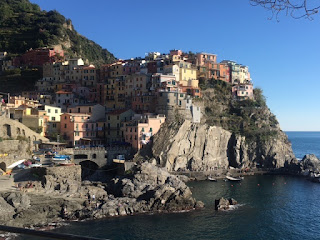It was Sunday morning, and I had just finished my daily wrestling match with the handheld shower tool when I heard fervent knocking on the bathroom door. “Did you feel that?” Deena was asking, and by the look on her face, I could tell something was amiss. She told me that she was lying in bed looking up at the ceiling when the large rectangular light fixture began swaying. She then found herself rocking back and forth in the bed and realized an earthquake was happening. Joseph and Deveny slept through it, no surprise there, and I never felt it, so Deena was our family’s only eyewitness to the central Italian earthquake of October 30, 2016, the most powerful quake to strike Italy since 1980. The earthquake registered 6.6 at the epicenter, and Rome received the last of the tremors—still disconcerting because it happened so spontaneously. Emergency preparedness experts always advise getting out of buildings or at least taking shelter under a door casing, but there is not much time when the ground starts heaving. That’s the fourth earthquake to strike this region in the last week—good thing we’re leaving Rome tomorrow and heading south to Mt. Vesuvius…
With our Sunday off in an early dubious direction, we got dressed, ate another quick continental breakfast, and headed off to our chosen place of worship, the Rome Baptist Church located in the Piazza di San Lorenzo in Lucina near the Pantheon. On corners throughout the city, there are continuously running fountains, decorated individually with water gushing from small brass spigots. The water flowing from these fountains is clean, cold, and refreshing, and by watching the locals, we’ve learned that if the flow is stopped by covering the bottom of the spigot with a finger, it redirects through a small hole in the top of the fitting resulting in an impromptu drinking fountain. We’ve been filling our bottles every morning at the neighborhood fountain, and on this day there were groups of people all around this gathering spot chattering and gesticulating wildly, and we assumed the earthquake was the topic of discussion.
Tram number eight, our mode of transportation to church, was packed—scary packed. Arguments broke out at every stop as people tried to board an already full car, and I was sweating in the crush of people trying to close my eyes and go to my happy place as is my custom in moments of claustrophobia. The streets were full of pedestrians, and the busses were brimming with riders in the early morning as well. I thought that maybe Romans head off to church in droves, but we found out later that they were making their way to the shopping districts to walk around and enjoy a weekend lunch with family and friends. After an uncomfortable thirty-minute ride, we extricated ourselves from the confines of the tram and walked unhindered in the crisp morning air. The Italian time change occurred earlier in the day, and the sun was already bright in the sky as we walked to church, but we had time to stop for a tour of the two-thousand-year-old Pantheon on the way. We stood under the world’s largest unreinforced concrete dome and looked through the oculus at the deep blue Roman sky, amazed at the preservation of this ancient building.
Pantheon dome
A few blocks later, we entered the Piazza di San Lorenzo and found the marble-cased entry to the Rome Baptist Church, where interim Pastor David greeted us with a warm handshake and a hearty “Good morning” enveloped in an accent born in the southern United States. The sanctuary was radiant with light streaming from the windows and covering every curve of the white-washed plaster ceiling and walls. Two large vases full of yellow and white flowers were on a table in front of a small lectern, and there was a small pipe organ filling the wall at the back of the altar. Dark-stained oak pews lined the center of the sanctuary, and the whole setting was not unlike that of a small country church in the US. For the next hour we joined the multiracial congregation in prayer and singing, and Pastor David delivered a sermon about discovering the will of God through simple steps of faith. David and his wife, Paulette, had been serving the church for the past month while the senior pastor was away, and they were preparing to return home to Knoxville, Tennessee. Near the end of the service, the visitors had the opportunity to stand and speak, and I introduced my family among visitors from the Netherlands, New Zealand, Germany, South Carolina, and a young couple from Raleigh, North Carolina. It was a great hour of worship at the Rome Baptist Church, and afterward we enjoyed sharing travel stories with other visitors over rich coffee and and a variety of biscuits.
Rome Baptist Church
For the next two hours, we wandered the old streets of Rome guided by serendipity as we happened upon small piazzas and ancient buildings tucked into corners of renaissance style housing rows. We eventually found ourselves at the base of the Trevi Fountain, where we lined up together and tossed coins over our shoulders into the water, ensuring our return to the Eternal City someday. We walked all the way to the Spanish Steps and found a restaurant where we enjoyed a lunch of spaghetti and meatballs, fried chicken, and a Caprese salad full of fresh tomatoes and mozzarella cheese. The tram ride back to our Monteverde neighborhood was thankfully uncrowded, and we returned to our apartment for a late afternoon nap and a supper of hot calzones from our favorite corner restaurant. We’re still trying to make up our minds on how we should spend our final day in the City of Seven Hills, but the past two days have been full and fruitful.
Trevi Fountain
Spanish Steps under a lot of tourists















































